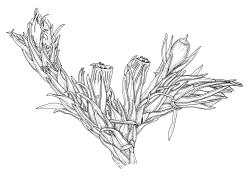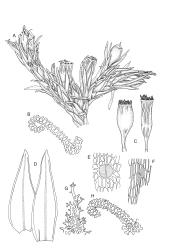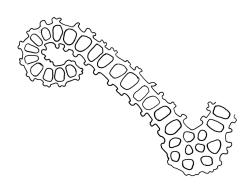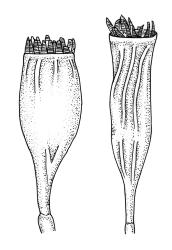Plants not glaucous when dry, olive-green to yellow-brown above, brown to black below. Leaf apices papillose but not erose. Mid laminal cells with papillae (1–)2–7(–9) µm tall and not or inconspicuously branched; cells near leaf apex with papillae to 22 µm.
Lewinsky 1984, fig. 8; Lewinsky 1987, figs 1–13; Vitt 1994, fig. 457; Ochyra et al. 2008, fig. 186.
Orthotrichum rupestre var. rupestre bears a superficial similarity to the often equally robust O. graphiomitrium. Both species often bear numerous weakly emergent capsules of various ages on much-branched shoots. However, in O. rupestre the dry mature capsules are furrowed, and the exostome (with a well-developed preperistome) is erect-spreading when dry. The endostome of O. rupestre is poorly developed and the species is largely confined to rock. In O. graphiomitrium, by contrast, the dry mature capsules lack furrows, the exostome is reflexed when dry and lacks a preperistome. The endostome in O. graphiomitrium is well-developed and observable with a hand-lens in dry material, and the species is nearly always epiphytic. The nature of the stomata (superficial in both species) is of no value in distinguishing the two species.
Orthotrichum rupestre var. rupestre, when sterile, could easily be mistaken for a Racomitrium, but under the microscope the non-sinuose nature of the laminal cells readily distinguishes it. When fruiting, as it is commonly, the nature of the capsules, calyptra, etc. readily distinguish it from any Racomitrium.
SI: Marlborough (Black Birch Range, Inland Kaikōura Range), Canterbury, Otago, Southland (near Athol). Lewinsky (1984, p. 398 characterised the N.Z. distribution of this variety as "common in Otago, scattered in Canterbury, rare in Marlborough" and provided a distribution map (fig. 9) for the country.
Nearly cosmopolitan. Mainland Australia*, North America*. Reported from Tasmania, Asia, E and S Africa, Europe, and South America by Lewinsky (1984, p. 398).
Mainly on non-calcareous rock and boulders but occasionally on the bark of the adventive genera Populus and Salix and also recorded from Discaria (Lewinsky 1984, tab. 1). Ranging from c. 60 m (Berwick, Otago L.D.) to c. 2300 m (Inland Kaikōura Range). Lewinsky (1984) considered this taxon to be restricted to areas with annual rainfall of <150 cm. The most common epilithic bryophyte associates are Schistidium apocarpum and Racomitrium crispulum s.l., but other species of Orthotrichum can also co-occur with it on rock. When growing on bark, O. rupestre var. rupestre can be associated with O. assimile, O. cyathiforme, O. hortense, and O. tasmanicum, as well as Calyptopogon mnioides and Ulota lutea.
Lewinsky (1984, p. 396) characterised the leaves of O. rupestre as "sometimes partially bistratose in upper part" in her key. This is a feature used by other workers (e.g., Crum & Anderson 1981, p. 696) to characterise it in other parts of its wide geographic range. However, the bulk, and possibly all, of N.Z. collections of O. rupestre have entirely unistratose upper laminal cells, and it is doubtful whether Lewinsky actually observed bistratose leaves here.
Lewinsky (1984) indicated that the stomata here are restricted to mid urn and below. Lewinsky’s observations agree with those of Crum & Anderson (1981) and Vitt (1994). However, material has been seen, including material determined by Lewinsky, in which the stomata are more numerous and more conspicuous above mid urn, and this pattern appears to be the norm in N.Z. material (e.g., D. Scott 140 from Upper Godley Valley, Canterbury L.D., CHR 613292; A.J. Fife 11443 from Lammermoor Range, Otago L.D., CHR 580181). This discrepancy in stomata distribution seems to have been noted by both Dixon (1926, p. 179) and Sainsbury (1955, p. 212). The taxonomic significance of this feature is beyond the scope of this work.
Lewinsky (1987) reported that the spore diameters in Australasian (ranging from 20–26 µm) material are greater than the spore diameters in North American and European material but similar to those she observed in South American and African material.







